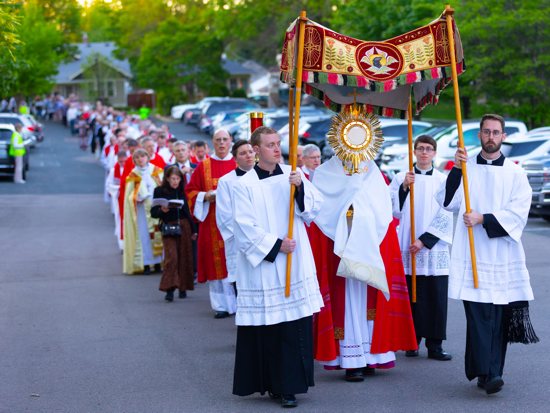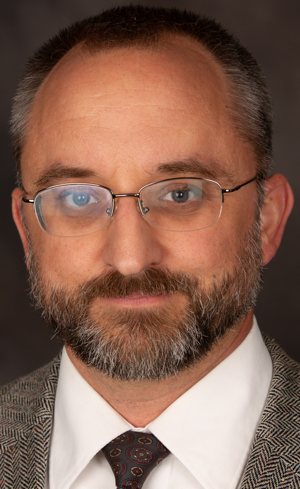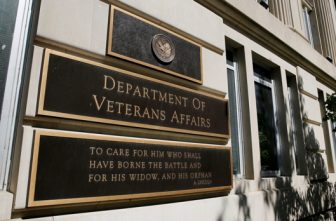
Editor’s note: The three-year National Eucharistic Revival of the U.S. Conference of Catholic Bishops has entered its National Eucharistic Pilgrimage phase of pilgrims traversing from four starting points around the country to converge July 17 in Indianapolis for the National Eucharistic Congress.
The procession on the northernmost Marian Route began May 19 at the headwaters of the Mississippi River. The pilgrims on this route will be in the Archdiocese of St. Paul and Minneapolis from May 24 to May 31.
Hoping to illuminate a few of the basics, The Catholic Spirit asked, “What is a Eucharistic procession? Why is this form of devotion important? Why is the Eucharist known by so many as the source and summit of the Catholic faith?
Associate Professor John Froula of The St. Paul Seminary in St. Paul provides some answers:
Almost a thousand years ago, the Church faced a crisis.
There were open challenges to the belief in the real presence of Christ in the Eucharist. Berengar of Tours, a prominent scholar, taught that Jesus was spiritually present and not bodily present in the Eucharist. In response to this crisis, there was a flowering of devotional practices and theological reflections that reinforced Catholic faith.

That is when Eucharistic processions as we might recognize them started to develop in different places throughout Christian Europe. Christ in the Eucharist was carried, as a group of people accompanied him through some geographic area, with prayers, praise, song and Benediction.
The current Eucharistic Revival is similarly a revitalization of faith in the Eucharist, and through it we see similar devotional expressions, like the National Eucharistic Pilgrimage.
Carrying Jesus in the Eucharist from one place to another goes way back to the early Church. There was a custom, for instance, of one bishop sending a consecrated host to another bishop for him to consume. This was a sign of ecclesial unity and goodwill in the one body of Christ.
Ecclesial unity extends from place to place and across time and generations. Eucharistic congresses are a reminder of that. The last National Eucharistic Congress was in St. Paul in 1941. The one faith in the one Christ expressed back then will be expressed in Indianapolis this summer. As a further reminder of that, the official monstrance used during the 1941 Eucharistic Congress will be used during the May 27 Source and Summit procession along Summit Avenue in St. Paul from The St. Paul Seminary to the Cathedral of St. Paul.
Why does the Catholic faith inspire a Eucharistic procession? The Church is a communion of charity. Human beings are social by nature. So, it is right that faith finds public witness, and that worship should be done in common. It is a beautiful witness that our belief is so visibly and obviously focused on Jesus during a procession.
A procession is also a reminder that we are pilgrims on the way. We walk with the Lord who accompanies us. Our destination is heaven, and the Eucharist is a pledge of eternal life and the medicine of immortality.
The Church embodies and extends the earthly mission of Christ. Eucharistic processions call to mind that we are sent by Christ to do the will of the Father. For example, seminarians processing from The St. Paul Seminary, where they discern and grow in their God-given vocation, to the Cathedral of St. Paul, where they are eventually ordained, heightens that sense of mission and call.
Pope Urban IV issued a decree establishing the celebration of Corpus Christi in the 13th century. In some ways, the solemnity of Corpus Christi was the consolidation of the Eucharistic revival that began 200 years prior. In that decree, Pope Urban wrote about the surpassing generosity in Christ giving himself in the Eucharist, where the giver becomes the gift in a complete way.
In his 1902 encyclical letter on the Eucharist, “Mirae caritatis” (“The Wonders of Charity”), Pope Leo XIII echoes Pope Urban and writes that we “… can do nothing good except in God through Jesus Christ, through whom every best and choicest gift has ever proceeded and proceeds. But the source and chief of all these gifts is the venerable Eucharist …” (6). Pope Pius XII, in his 1947 encyclical letter “Mediator Dei,” writes “The head and center, as it were, of the Christian Religion is the Mystery of the Most Holy Eucharist.”
This understanding of the Eucharist as both origin in some way and highest in some way found its most classic and popular formula in the Second Vatican Council. The document on the Church, “Lumen gentium,” calls the Eucharistic sacrifice the source and summit of the whole Christian life. The original Latin is sometimes translated as “font and apex,” but “source and summit” has a certain ring to it. This teaching is repeated in many subsequent magisterial documents with various nuances, including the Catechism of the Catholic Church.
One way of seeing how the Eucharistic sacrifice is both source and summit is to see how it is both the presence of Christ in his saving acts, and an act of worship that God allows the Church to participate in. Christ in his redemptive sacrifice is made present in the Eucharist: the source of our supernatural life and union with God. At the same time, the Mass is the summit of Christian activity in the glorification of God, a vital activity that encompasses charity and the Church’s charisms.
While those who named Summit Avenue may not have been thinking about the Eucharist at the time, there is no summit that can’t remind us of the holy hill of Calvary, and the heavenly Zion where we ascend with Christ as food for the journey.
Froula is an associate professor of dogmatic theology at The St. Paul Seminary.




